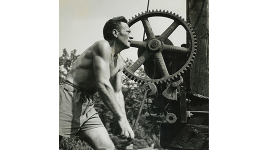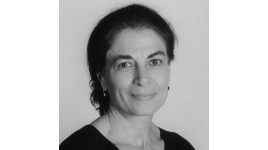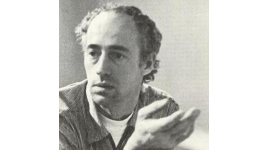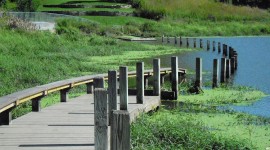The Cultural Landscape Foundation’s Landslide® 2014: Art and the Landscape – Eleven Threatened and At-Risk Sites
Media Contact: Nord Wennerstrom | T: 202.255.7076 | E: nord@tclf.org
A Diverse Group of Culturally Significant Sites in CA, IA, MI, NJ, NM, NY, TX and WA, Including the Frick Collection's Russell Page-designed Garden, the World's Largest L.E.D. Sculpture, Folk Art Masterworks in Urban Settings, Athena Tacha's Extant Public Commissions & the Wells Petroglyph Preserve, Threatened with Demolition, Neglect, Poor Maintenance, Vandalism and Lack of Funding
Washington, DC (October 22, 2014) – The Cultural Landscape Foundation (TCLF) today announced Landslide® 2014: Art and the Landscape – with eleven examples of land-based art from ancient to modern threatened with demolition, neglect, poor maintenance, vandalism and lack of funding. Landslide is TCLF’s annual thematic compendium of threatened and at-risk landscapes and landscape features. The eleven sites, selected from more than 100 submissions, include: the refined 70th Street Garden at the Frick Collection in New York, by the internationally significant British landscape architect Russell Page; the Bay Lights, the world’s largest L.E.D. sculpture, located in San Francisco; large-scale, handmade folk art creations in urban neighborhoods in Los Angeles and Detroit; single artist, multi-acre installations in Joshua Tree, California and Saugerties, New York; ancient rock art in the New Mexico’s Wells Petroglyph Preserve; projects by Mary Miss and Robert Morris, pioneers in site-specific earth art installations; the extant body of work of the Greek-American, Washington, D.C.-based artist Athena Tacha; and others. Narratives about all the sites accompanied by newly commissioned photographs are available on TCLF’s Web site (www.tclf.org/landslide2014). The announcement was made at an event in New York at the studio of artist Marylyn Dintenfass. Landslide is made possible by Presenting Sponsor The Davey Tree Expert Company, Education Partner the American Society of Landscape Architects and Media Partner Landscape Architecture magazine.
Landslide first issued in 2003, has highlighted more than 200 significant at-risk parks, gardens, horticultural features, working landscapes and other places that collectively embody our shared landscape heritage.
“The interrelationship of art and the landscape has yielded diverse, historically significant and irreplaceable representations of our cultural identity; however, they are often fragile, overlooked and threatened,” said Charles A. Birnbaum, TCLF Founder and President.
The sites on Landslide 2014: Art and the Landscape:
Watts Towers, Simon Rodia, Los Angeles, CA
In 1921, Southern Italian immigrant Sabato Rodia (1879-1965), began construction of the Watts Towers, a group of seventeen, steel reinforced seashell, pottery, tile and glass studded cement stucco sculptures – two of which are nearly 100 feet tall – that took 34 years to complete. Rodia built his towers without the benefit of machine equipment, scaffolding, bolts, rivets, welds, or drawing board designs. He used salvaged steel of various shapes and sizes that he bent by hand to shape and secured with wire. This armature was then wrapped with wire mesh and covered with Portland cement hand formed into various shapes. Today the project, a National Historic Landmark, and City of Los Angeles Historic-Cultural Monument No. 15 is part of the Simon Rodia State Historic Park. However, the site, which has had multiple owners, has not always received proper maintenance. In October 2010 the Los Angeles County Museum of Art entered into a partnership with the Los Angeles Department of Cultural Affairs to develop a comprehensive conservation management plan. A city funding has been appropriated that could cover some restoration and the public are encouraged to advocate the use of those funds for the restoration and continued maintenance of Watts Towers.
The Heidelberg Project, Tyree Guyton, Detroit, MI
Detroit native Tyree Guyton first began transforming and repurposing vacant houses in a stretch of the city’s Heidelberg Street neighborhood in 1986. Guyton assembled discarded everyday objects and affixed them to houses, cars, and trees, creating themed installations out of shoes, clocks, bicycles and various other items. He painted colorful shapes, numbers, and letters on sidewalks, streets and other surfaces. The project was twice partially demolished by the city in the 1990’s, and a series of fires in 2013-2014 destroyed many of the remaining installations. Nevertheless, supporters are actively fund raising for repairs and maintenance, and working to get the site official City recognition.
70th Street Garden, The Frick Collection, Russell Page, New York, NY
The Frick Collection garden on East 70th Street in New York is a rare surviving U.S. commission by the influential British landscape architect Russell Page (1906-1985) and deemed by the New York Times as one of his “most important works.” The garden was built on a site once slated for an addition to the museum. However, in 1973 those plans were abandoned and Frick officials instead said they planned a “permanent garden” on the site. Page created a viewing garden, designed to be seen from the street and the museum, and not open to the public (though numerous museum events are held there). In 2014 Frick officials, now claiming the garden was temporary, announced new expansion plans that would demolish the site. The museum will need the approval of New York’s Landmarks Preservation Commission if the demolition is to take place.
Noah Purifoy Outdoor Desert Art Museum of Assemblage Sculpture, Noah Purifoy, Joshua Tree, CA
The Noah Purifoy Outdoor Desert Art Museum of Assemblage Sculpture sits on ten-acres in the Mojave Desert foothills near the Mojave National Preserve, an austere expanse of scrubby desert and jagged mountains. The site holds the home, studio, and sculpture park of renowned assemblage artist Noah Purifoy (1917 -2004) who lived there from 1989 until his death in 2004. Purifoy created 77 artworks and installations on the desert floor over the course of fifteen years and a total of 120 artworks are housed on the site, some made with tires, bowling balls, railroad ties, vacuum cleaners, charred wood, and old car parts. Wind and weathering, which the artist expected, have degraded many of these works so that they necessitate ongoing maintenance.
Opus 40, Harvey Fite, Saugerties, NY
Starting in 1939, artist Harvey Fite (1903-1976) began work on the 6.5-acre Opus 40, on a twelve-acre parcel in High Woods, Saugerties, New York he’d purchased the year before. On this site within the foothills of the Catskills Escarpment with Overlook Mountain, the southernmost peak of the range as a backdrop, the largely self-taught artist created a monumental abstract work using rubble from an abandoned bluestone quarry on the property. He adapted dry key stone masonry, a traditional technique of fitting stone upon stone without mortar, working on the project until his death in 1976. Hurricanes Irene (2011) and Sandy (2012) caused damage to several portions of the site. Then, water buildup exacerbated by both these storms caused a 14-foot high vertical wall in one of the oldest parts of the site to collapse. Funding is needed for repairs and maintenance.
Wells Petroglyph Preserve, Archaic and Ancestral Puebloans, NM
Petroglyphs, forms of rock art in which images and/or symbols are carved or otherwise marked on rock, can be found in Africa, the Americas, Asia, Australia, and Europe, with some dating back 40,000 years. The 8,000-10,000 images, including representations of humans and animals, at Wells Petroglyph Preserve in northern New Mexico’s 36-square-mile Mesa Prieta, were created over a 7,500-year period. Set along the El Camino Real de Tierra Adentro National Historic Trail, Mesa Prieta, which holds an estimated 70,000 petroglyphs, is the state’s largest petroglyph site. The most significant threat is from erosion, which is being exacerbated by a multi-year drought. The Mesa Prieta Petroglyph Project has enacted several programs to help protect the site, but has struggled to keep up with recent damage. Funding is needed to stabilize sections and provide maintenance.
Greenwood Pond: Double Site, Mary Miss, Des Moines, IA
Commissioned by the non-profit Des Moines Art Center, artist Mary Miss’s outdoor installation, Greenwood Pond: Double Site is one of only eight of the artist’s extant permanent landscape works. The influential and award-winning artist worked from 1989 to 1996 with local citizen groups, municipal agencies and scientists to plan and execute the project, which the Greater Des Moines Public Art Foundation calls the nation’s “first urban wetland project.” Time, weather and vandalism have taken their toll on the materials that comprise the wooden structures of Double Site. Without proper funding to make improvements the site will continue to deteriorate.
Untitled (Johnson Pit No. 30), Robert Morris, SeaTac, WA
In 1978, the King County Arts Commission in Seattle, Washington sought to engage artists to find solutions for the county’s “technologically abused land.” They proposed a symposium titled Earthworks: Land Reclamation as Sculpture to be held in August 1979 that would include a demonstration project. Of the 22 artists who were invited to submit proposals, eleven did so and a three-person jury selected artist Robert Morris to work on Johnson Pit No. 30, an abandoned gravel pit that the Department of Public Works donated to the county. Completed in November 1979, Morris’ artwork consists of a series of concentric slopes planted with rye grass, which descend into the reclaimed gravel pit, which occupies the center of the site. Encroaching residential development, illegal dumping, vandalism and inadequate funding all pose threats.
Extant body of public commissions, Athena Tacha, various locations in the U.S.
The Greek-American, Washington, D.C.-based artist Athena Tacha created some of the earliest site-specific environmental sculptures. The artist, who studied sculpture and art history, before receiving a Ph.D. in Aesthetics from the Sorbonne in Paris, France, completed her first outdoor sculpture in 1971. Tacha works with a wide range of elements, including stone, brick, steel, water, plantings, and L.E.D. (light-emitting diode) lighting. Of her 40 public commissions, 37 were realized – today 30 survive. Some of Tacha’s works are at-risk from demolition, alteration, and diminished maintenance, including Green Acres, a 1985 installation at the New Jersey State Department of Environmental Protection in Trenton.
Bay Lights, Leo Villareal, San Francisco, CA
New York-based artist Leo Villareal’s monumental installation, which opened in March 2013, features 25,000 white L.E.D.s arrayed along the 1.8-mile, 500-foot-high western span of San Francisco’s Willie L. Brown Jr. Bridge. The $8 million, privately financed project – the world’s largest L.E.D. sculpture – features computer controlled constantly changing patterns of shimmering light displays. The idea was conceived in 2010 by Ben Davis of the communications firm Words Pictures Ideas to celebrate the Bridge’s 75th anniversary. The Bay Lights installation was initially contracted for a two-year term ending in March 2015, when the bridge undergoes previously scheduled maintenance. A campaign called Keep ‘Em Lit through 2026, is currently underway to fund the popular project’s long-term reinstallation.
White Rock Lake Wildlife Water Theater, Frances Bagley and Tom Orr, Dallas, TX
In Dallas’ 1,000+-acre White Rock Lake Park, sculptors Tom Orr and Frances Bagley, who are husband and wife, created what Nasher Sculpture Center director Jeremy Strick says is “among the most successful and admired works of public art in Dallas.” White Rock Lake Wildlife Water Theater was dedicated in November 2001 as part of Dallas, Texas’ Percent for Art program. Erected just off the shores of the park’s manmade lake are several dozen slender steel rods inspired by the organic shapes of cattails. The project, which opened in 2001, was created as habitat for native wildlife where visitors could observe and learn about the behavior of indigenous birds, fish, and turtles. In 2009 the City of Dallas cut out its maintenance funding for public art and more recently the City’s Office of Cultural Affairs has proposed deaccessioning the work and having it destroyed. Public outcry has forced the Office of Cultural Affairs to take a second look and to host a series of public meetings to discuss the subject.
Landslide® is one of many TCLF initiatives that collectively highlight the importance of the nation’s rich and diverse landscape legacy. TCLF has also created What's Out There®, a free, searchable online database of the nation’s designed landscapes, that currently includes more than 1,700 sites, 10,000 images and 900 designer profiles; the Pioneers of American Landscape Design® with extensive biographies and profiles of hundreds of practitioners: Pioneers video oral histories with significant practitioners; along with tours, symposia, books, and lectures.
About The Davey Tree Expert Company
The Davey Tree Expert Company (www.davey.com), with US and Canadian operations in 45 states and five provinces, provides a variety of tree services, grounds maintenance, and consulting services for the residential, utility, commercial, and government markets. Founded in 1880, Davey is employee owned and has more than 7,000 employees.
About the American Society of Landscape Architects (ASLA)
Founded in 1899, ASLA (www.asla.org) is the national professional association for landscape architects, representing more than 15,000 members in 48 professional chapters and 68 student chapters. The Society's mission is to lead, to educate and to participate in the careful stewardship, wise planning and artful design of our cultural and natural environments. Members of the Society use their "ASLA" suffix after their names to denote membership and their commitment to the highest ethical standards of the profession.
About Landscape Architecture magazine
Founded in 1910, Landscape Architecture magazine (http://landscapearchitecturemagazine.org) is the publication of the American Society of Landscape Architects. It is published each month for more than 22,500 subscribers and newsstand sales. The mission of the magazine is to elevate the practice of landscape architecture by providing timely information on built landscapes and on new techniques for ecologically sensitive planning and design. Learn more at: .
About The Cultural Landscape Foundation
The Cultural Landscape Foundation (TCLF) is a 16-year-old non-profit foundation that provides people with the ability to see, understand and value landscape architecture, its practitioners and our shared landscape legacy, in the way many people have learned to do with buildings and their designers. Through its Web site, lectures, outreach and publishing, TCLF broadens the support and understanding for cultural landscapes nationwide to help steward this heritage for future generations. TCLF makes a special effort to heighten the awareness of those who impact cultural landscapes, assist groups and organizations working to increase the appreciation and recognition of cultural landscapes, and develop educational tools for young people to better connect them to their cultural landscape environs.











